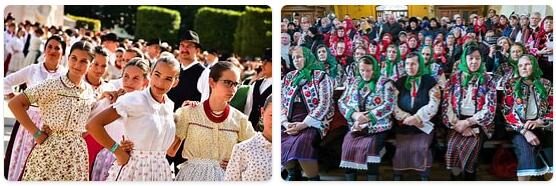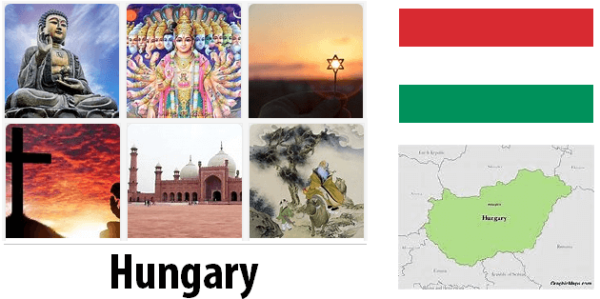Hungary is a Central European country located in the Carpathian Basin and bordered by Slovakia, Ukraine, Romania, Serbia, Croatia, and Austria. It has a population of approximately 9.7 million people and its official language is Hungarian. Hungary is a parliamentary republic with an elected president who serves as the head of state. Its capital city is Budapest, which is also its largest city with a population of 1.7 million people. Hungary has a rich cultural heritage that can be seen in its architecture and art, especially in the cities of Budapest and Eger. The country also boasts many beautiful natural attractions such as Lake Balaton, the Danube River Valley, the Hortobágy National Park and numerous thermal baths across the country. Hungary’s economy is largely dependent on tourism as well as food processing and automotive industries. See countryaah.com for other countries that start with letter H.
Population
Hungary has a population density of 107 residents per km 2 with the largest population concentrations in the Budapest, Miskolc and Szeged areas. Through the post-World War I borders, Hungary became a relatively homogeneous state; the ethnic Hungarians make up 90-95 percent of the population. The largest minority group is the Roma, which is estimated to be 4–6 percent; other groups are Germans (2 percent) and Slovaks (1 percent).
Hungary has for a long time had a negative natural population change. The proportion of residents in cities is 71 percent. The largest cities are Budapest (1.8 million residents, 2017), Debrecen (202,000) and Miskolc (157,200).

Language
Due to Hungary’s large post-World War II country resettlement, Hungarian is the dominant language in the country. Among minority languages, primarily Romani. Smaller groups speak Romanian and German.
Religion
Christianity reached present-day Hungary already during Roman times. During the 9th century, missions from both Byzantine and German existed. When Hungary transitioned to Christianity under Stefan I (about the year 1000), they joined the Latin Western Church. The Archbishop’s seat became Esztergom. Through the Reformation a Lutheran and a Reformed Church arose. In 1988, 66% of Roman Catholics, 18% of Reformed, 4% of Lutherans and all other communities were counted 2.4%. During the communist era, the religious communities were strongly oppressed. In 1990 freedom of religion was introduced. Seized property was returned to the communities during the 1990s. The number of Roman Catholic orders is steadily increasing.
1526 Under Ottoman rule
According to thesciencetutor, in 1526, Hungary was conquered by the Ottoman Empire. The first sultan supported Zapolya of Habsburg as successor to the king who had fallen in war. When Zapolya himself died, however, the Sultan occupied Budapest and a larger part of the central and southern part of the country. Croatia, the western and northern parts of Hungary were still in the hands of Ferdinand of Habsburg, but were forced to pay tribute to the Turkish Empire.
The Turks destroyed the high late medieval culture created in the Hungarian lowlands. The old feudal structure decayed and hundreds of thousands left the Turkish territories that were almost broken as the Austrians moved east and conquered central Hungary after defeating the Turks during the Battle of Vienna in 1683. From now until 1918, the Habsburgs ruled Hungary, except from short rebel periods. Formally, it was an equal personnel union, but the strong nationalism of the Hungarians, constant social tensions and Austrian attempts at domination still created unrest. The most important revolt was under Ferenc Rakoczi, who after 1700 tried to create an independent Hungarian kingdom. The uprising failed, but has since been an important source of inspiration for Hungarian national sentiment. The Hungarians opposed the Habsburg emperors and especially Joseph II’s attempt to centralize and Germanize the country in the 1780s. Nationalist-Jacobean insurgency attempts after the French Revolution were severely beaten, without the failure of the Habsburgs and their allies – the Hungarian magnates – to suppress the freedom and national feeling of the Hungarians. But the country continued to be an agrarian feudal state, and was the economically weaker party in the Austro-Hungarian monarchy.
1919 The Hungarian Soviet Republic
Now the Hungarian Soviet Republic followed. It became a strange interplay in the history of the European labor movement. The strong man of the Republic was Bela Kun, who was later killed by Stalin. The communist experiment in central Europe lasted only 133 days before being defeated by Admiral Miklos Horthy’s white troops with the help of Romanian intervention forces. Despite all the confusion and certain abuses, the Soviet Republic was characterized by a genuine socialist idealism, and it received widespread support – not just in the working class, but also from leading intellectuals.
